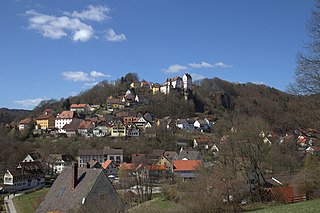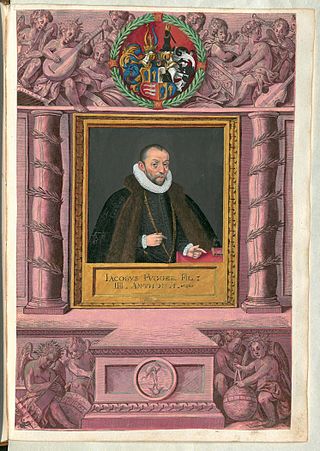

Schloss Hundshaupten is a quadrangular castle in the village of Hundshaupten in the municipality of Egloffstein in the German county of Forchheim.


Schloss Hundshaupten is a quadrangular castle in the village of Hundshaupten in the municipality of Egloffstein in the German county of Forchheim.
The castle is recorded for the first time in 1369 in the ownership of the Lords of Wiesenthau. It was, like almost all castles in Franconian Switzerland, built on a hill spur of the Franconian Jura plateau jutting out into the valley. Following its destruction in 1388 by Nuremberg during the War of the Cities, in 1412 by Burgrave Frederick VI of Nuremberg and in 1525 during the Peasants' War, then it was rebuilt in 1561.
In 1613, when the Wiesenthau line at Hundshaupten died out, the fief reverted to Michelsberg Abbey in the city of Bamberg. In 1661, after the Thirty Years' War, the abbey sold the castle to Hieronymus Christopher, Freiherr of Pölnitz, town commandant of Forchheim, who resided in Aschbach, now a village in the municipality of Schlüsselfeld. In the years that followed, work was carried out, but its castle character was not changed.
During 1991, part of the estate was gifted by Gudila, Freifrau of Pölnitz to the county of Forchheim, including Hundshaupten Wildlife Park.
Hieronymus Christopher Heinrich Freiherr von Pölnitz, great nephew and adoptive son of Götz Freiherr von Pölnitz and Gudila Freifrau von Pölnitz continue to live there.
The meaning of the placename of Hundshaupten can no longer be explained with certainty today. There are several possibilities that have been suggested and compared by Dorothea Fastnacht.
The names of the neighbouring villages of Hundshaupten and Hundsboden should be seen as connected. The suffix, '-haupten' probably refers to the hill spur on which, initially a castle and, later, the present schloss were built. By contrast, the suffix, '-boden', suggests a level field of fertile soil on the plateau that was cleared in the High Middle Ages as part of the expansion of cultivated land. The prefix 'Hund-' probably refers to the owner of the clearance and the castle, with the office of a Hunno (chief of a Hundertschaft). With the firm establishment of feudal lordship, this office became hereditary during the High Middle Ages and filled by local nobility. Originally, during the Migration Era and in the Early Middle Ages the leader of a community of free farmers was called a Hunno.
Below Schloss Hundshaupten in a stand of old beech trees between the rocks of the Jura lies a family cemetery. The first interment was in 1944 was of Geheimrat Paul Fridolin Kehr. Family members who had died earlier were transferred here. The following members of the Pölnitz family are buried here:
Memorial tablet for:

Oskar Freiherr von Redwitz was a German poet from Lichtenau, Bavaria. Having studied at the universities of Munich and Erlangen, he was apprenticed to the law in the Bavarian State service (1846–49).
Countess Nina von Stauffenberg was the wife of Colonel Claus Schenk Graf von Stauffenberg, the leader of the failed plot to assassinate Adolf Hitler on 20 July 1944. Following the plot's failure, she was arrested and imprisoned, during which time she delivered her youngest child.

Henriette Mendel, Baroness von Wallersee was a German actress, and the mistress and, later, morganatic wife of Ludwig Wilhelm, Duke in Bavaria. By him she was the mother of Countess Marie Larisch von Moennich.

The House of Bibra was one of the leading Uradel families in Franconia and present day Thuringia from the mid-15th century to about 1600. Later on the family rose from Reichsritter to Reichsfreiherr. After the Holy Roman Empire dissolved, they were made ‘’Freiherr’‘ (Barons) of Bavaria and Bohemia.
Count Franz-Ludwig Schenk von Stauffenberg is a German lawyer and politician from the CSU. He was a member of the Bundestag from 1976 to 1987 and of the European Parliament from 1984 to 1992. He is the son of World War II colonel and resistance leader Claus von Stauffenberg.

Franz Xaver Joseph Ignaz Freiherrvon Hertling was a Bavarian lieutenant general and War Minister from 12 December 1836 until 11 November 1838.
Johann Friedrich Maximilian Joseph Freiherrvon Hertling was a Bavarian Lieutenant General that acted as the War Minister for Bavaria from 28 January until 9 June 1839. He was the brother of Franz Xaver von Hertling.

Leonhard Freiherrvon Hohenhausen und Hochhaus was a Bavarian military and Acting War Minister from 1 March 1847 to 1 February 1848. His last military rank was General der Kavallerie.

Maximilian "Max" Freiherrvon Speidel was a Bavarian general and State Council at the Bavarian Ministry of War.

Franziska Freifrauvon Reitzenstein was a German novelist.
Christian Marianne Wilhelm August Franz Freiherrvon Zweibrücken, before 1792 Graf von Forbach, was a Bavarian General der Kavallerie, and later Generalkapitän of the Leibgarde der Hartschiere. He may not be confused with his uncle Christian Freiherr von Zweibrücken, who was a Bavarian General der Infanterie.
Christian Grafvon Forbach, then Christian Marquis de Deux-Ponts and later Christian Freiherrvon Zweibrücken was an officer of the French Army and later a general of the Royal Prussian and then of the Bavarian Army, at last in the rank of General der Infanterie. He should not be confused with his nephew Christian Freiherr von Zweibrücken, who was a Bavarian General of Cavalry.

Philippe Guillaume aka Philipp Wilhelm Grafvon Forbach, then Vicomte de Deux-Ponts and later Freiherrvon Zweibrücken (1754–1807) was an officer of the French and later general of the Bavarian Army.

Gottfried, Count Huyn, Baron of Geleen or Godefridus Comes ab Huyn Baro de Geleen, rose to the rank of Field Marshal in the service of the Holy Roman Emperor during the 30 Years War.

Egloffstein Castle is a former high mediaeval, aristocratic castle, that stands immediately west of the eponymous village of Egloffstein in the Upper Franconian county of Forchheim in the German state of Bavaria.

The House of Egloffstein is an ancient Franconian aristocratic family (Uradel) with an eponymous family home in the hill region of Franconian Switzerland in the Bavarian province of Upper Franconia. The family first appears in the records in 1187 with a Heinrich genannt Stuchs who is also the progenitor. The house belongs to the brotherhood of Franconian Imperial Knights. Egloffstein Castle and Kunreuth Castle are to this day owned by the family.

Gaillenreuth Castle is situated high above the Wiesent river on its upper western perimeter in the village of Burggaillenreuth. The village belongs to the borough of Ebermannstadt in the county of Forchheim in the south German state of Bavaria. All that survives is the southern part of the hill castle. As well as parts of the outer ward there is a tower house from the post-1632 period.

Hans Maria Clemens Franz Konstantin Freiherrvon Podewils-Dürniz was a Bavarian politician who served as Minister-President of Bavaria 1903–1912.

Jakob III. Fugger was a German businessman and landowner of the Fugger family. He was also Lord of Schloss Babenhausen in Unterallgäu.
Hieronymus Christoph Jan Eugen Franz Gottfried Maria Freiherr von Pölnitz, known as Götz Freiherr von Pölnitz was a German social historian, economic historian and archivist.